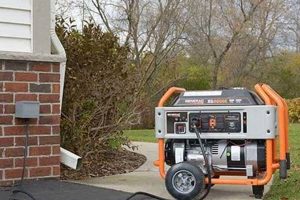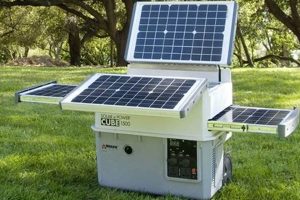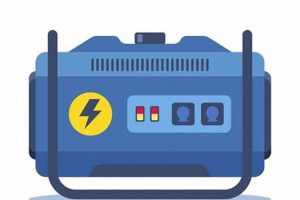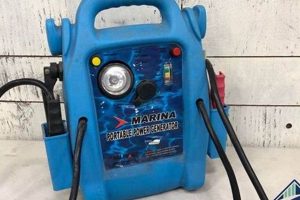A self-contained system designed for temporary electrical supply during outages typically includes a compact generator, essential accessories, and sometimes basic tools. Such systems often feature items like extension cords, fuel containers, and a maintenance guide, providing a ready-to-use solution for powering critical appliances and devices. For instance, a homeowner might utilize such a system to operate a refrigerator, sump pump, or essential medical equipment during a power outage caused by a severe storm.
Backup electrical systems offer crucial support during unforeseen events, ensuring continuity of essential services and enhancing safety. Historically, reliance on candles and other rudimentary light sources posed significant risks during prolonged power failures. The advent of compact, fuel-powered generators marked a substantial improvement in emergency preparedness, providing a reliable means to power necessary equipment and mitigating risks associated with extended blackouts. This capability is especially vital in areas prone to natural disasters or where grid infrastructure is less robust.
Further exploration of this topic will cover key aspects such as selecting the appropriate generator size, understanding various fuel types and their respective advantages, proper maintenance procedures, and essential safety guidelines for operation and storage.
Essential Tips for Emergency Power Systems
Proper planning and execution are critical for maximizing the effectiveness and safety of a backup power solution during an outage. The following tips offer guidance for optimal implementation.
Tip 1: Calculate Power Requirements: Determine the wattage needed to run essential appliances and devices. Prioritize necessities like refrigerators, sump pumps, and medical equipment. Overloading the generator can lead to damage and system failure.
Tip 2: Select Appropriate Fuel Type: Consider factors such as availability, storage capacity, and environmental impact when choosing between gasoline, propane, and other fuel options. Ensure adequate fuel storage for anticipated outage durations.
Tip 3: Prioritize Safety During Operation: Always operate the generator outdoors in a well-ventilated area, away from windows and doors. Carbon monoxide poisoning is a serious risk. Never refuel a hot generator.
Tip 4: Perform Regular Maintenance: Adhere to the manufacturer’s recommended maintenance schedule. Regular oil changes, air filter cleaning, and spark plug replacements are essential for reliable performance.
Tip 5: Conduct Periodic Testing: Test the system monthly to ensure proper functionality. Simulate an outage by disconnecting the main power supply and running essential appliances on the generator. This helps identify potential issues and ensures readiness.
Tip 6: Store Fuel Safely: Store fuel in approved containers in a cool, dry, and well-ventilated location away from ignition sources. Rotate fuel stocks to maintain freshness and prevent degradation.
Tip 7: Consult Local Regulations: Be aware of local ordinances regarding generator usage, including noise restrictions and permitting requirements.
Implementing these tips will help ensure safe and reliable backup power during emergencies, minimizing disruption and safeguarding essential operations.
Following these preparatory steps and operational guidelines enhances safety and ensures efficient power delivery when it matters most. This proactive approach minimizes disruption and provides peace of mind during unforeseen events.
1. Power Output (Wattage)
Power output, measured in watts, represents a critical specification within portable generator emergency power kits. This figure directly dictates the number and type of appliances the generator can simultaneously operate. Understanding wattage requirements for essential devices is paramount. An insufficient power output can lead to system overload, causing damage to both the generator and connected appliances. Conversely, an excessively high wattage may result in unnecessary fuel consumption and increased operational costs. For example, a refrigerator might require 700 watts to start and 200 watts to run, while a sump pump could demand 1000 watts initially and 400 watts during operation. Accurately calculating total wattage needs ensures appropriate generator selection.
Several practical considerations arise concerning wattage. Running appliances with high starting wattage, such as refrigerators or air conditioners, often necessitates a generator with surge capacity exceeding the combined running wattage. Prioritization of essential devices becomes crucial during outages. Operating less critical appliances can be deferred to avoid overloading the generator. Calculating wattage needs for various scenariosminimal operation versus powering essential medical equipment, for instanceenables informed decisions about generator capacity and ensures adequate power during emergencies.
Careful wattage assessment forms the foundation of a functional emergency power plan. Understanding power demands and generator capacity ensures effective operation, preventing equipment damage and maximizing the utility of the portable generator emergency power kit during critical situations. This knowledge empowers users to match their power needs with appropriate generator specifications, ensuring uninterrupted operation of essential devices when grid power is unavailable.
2. Fuel Type and Capacity
Fuel type and capacity are integral considerations within portable generator emergency power kits, directly influencing operational duration, storage logistics, and environmental impact. Common fuel types include gasoline, propane, and diesel. Each presents distinct advantages and disadvantages. Gasoline offers widespread availability but poses storage challenges due to flammability and shelf-life limitations. Propane, while requiring larger, heavier tanks, provides extended storage stability and cleaner combustion. Diesel, though less common in portable generators, delivers superior efficiency and extended runtimes.
Capacity, typically measured in gallons or pounds, determines the generator’s potential runtime on a single tank. A larger fuel capacity allows for extended operation without refueling, crucial during prolonged outages. However, increased capacity often translates to larger, heavier fuel tanks, impacting portability and storage. Practical considerations include balancing runtime requirements with storage limitations and fuel availability. For instance, a homeowner in a hurricane-prone area might prioritize a larger propane tank for extended operation during power disruptions, while someone seeking backup for occasional short outages might opt for a smaller gasoline-powered unit.
Careful consideration of fuel type and capacity is crucial for optimizing a portable generator emergency power kit. Matching fuel characteristics with anticipated outage duration and storage capabilities ensures reliable power delivery during critical situations. Understanding the trade-offs between different fuel types and capacities enables informed decisions aligned with specific needs and circumstances. This knowledge empowers users to maximize the effectiveness of their emergency power systems while adhering to practical constraints and safety considerations.
3. Runtime and Efficiency
Runtime and efficiency are critical performance indicators for portable generator emergency power kits. Runtime, often measured in hours, signifies the duration a generator can operate continuously on a full tank of fuel. Efficiency, typically expressed as a percentage or in gallons per hour, reflects how effectively the generator converts fuel into usable electricity. These factors are intrinsically linked; a more efficient generator will generally offer a longer runtime on the same amount of fuel. This relationship becomes especially important during extended power outages, where minimizing fuel consumption and maximizing operational duration are paramount.
Consider two generators with identical fuel tank capacities. A less efficient model might provide only 6 hours of runtime, while a more efficient unit could deliver 10 hours or more. This difference can be crucial in scenarios requiring prolonged operation, such as extended power outages caused by natural disasters. Efficiency also impacts operating costs; a less efficient generator consumes more fuel, leading to higher expenses over time. Real-world examples include situations where homeowners need to power essential appliances like refrigerators and sump pumps during multi-day outages. In such cases, a generator with a longer runtime and higher fuel efficiency significantly reduces the frequency of refueling, minimizes operational costs, and ensures continuous power supply to critical devices.
Understanding the interplay between runtime and efficiency allows for informed decisions when selecting a portable generator emergency power kit. Prioritizing efficiency ensures not only longer operational duration but also reduces fuel consumption and associated expenses. This knowledge empowers consumers to select generators optimized for their specific needs, ensuring reliable power during critical situations without excessive fuel consumption or frequent refueling. Ultimately, selecting a generator with appropriate runtime and efficiency contributes significantly to the overall effectiveness and practicality of an emergency power plan.
4. Safety Features (CO sensor)
Safety features, particularly carbon monoxide (CO) sensors, are paramount in portable generator emergency power kits. Carbon monoxide, an odorless, colorless, and highly toxic gas, poses a significant threat during generator operation. Generators produce CO as a byproduct of combustion. Operating a generator in a confined or poorly ventilated space can lead to dangerous CO buildup, potentially resulting in severe health consequences or fatalities. CO sensors play a crucial role in mitigating this risk. These devices continuously monitor CO levels and trigger an alarm when concentrations reach hazardous thresholds, alerting users to the danger and allowing for timely intervention.
The inclusion of CO sensors in portable generator kits is not merely a beneficial addition but a critical safety requirement. Real-world incidents underscore the life-saving potential of these devices. Cases of CO poisoning have occurred due to improper generator placement, such as operating the unit inside a garage or near open windows. CO sensors provide an essential layer of protection, alerting individuals to the presence of this invisible threat even before physical symptoms manifest. Furthermore, advancements in CO sensor technology have led to features like automatic shutoff, which deactivates the generator when dangerous CO levels are detected, further enhancing safety. This proactive approach prevents potentially tragic outcomes by automatically mitigating the source of the CO emission.
Prioritizing CO safety is non-negotiable when utilizing portable generators. Understanding the critical role of CO sensors, their functionality, and the potential consequences of CO exposure is essential for safe operation. Investing in a portable generator equipped with a reliable CO sensor, coupled with adherence to proper ventilation practices during operation, significantly reduces the risk of CO poisoning and ensures the safe utilization of emergency power during critical situations. This understanding underscores the fundamental connection between safety features and the responsible use of portable generator emergency power kits.
5. Portability and Size
Portability and size are crucial factors influencing the practicality and usability of portable generator emergency power kits. These characteristics directly affect transportation, storage, and deployment during critical situations. Compact, lightweight generators offer greater ease of movement and require less storage space, making them ideal for various applications, from camping trips to emergency home backup power. Conversely, larger, heavier units, while potentially offering higher power output, may present challenges in maneuverability and storage, particularly for individuals with physical limitations or limited storage capacity. The interplay between portability and size impacts the overall effectiveness of the emergency power solution.
Consider the scenario of a natural disaster requiring evacuation. A compact, easily transportable generator allows individuals to quickly relocate with their essential power source, ensuring continued operation of critical devices during displacement. Alternatively, in a home backup power scenario, a smaller generator can be conveniently stored in a garage or shed, readily accessible during power outages. However, larger generators might necessitate dedicated storage solutions, potentially impacting accessibility. Real-world applications highlight the practical significance of these considerations, demonstrating the direct relationship between portability, size, and the effective deployment of emergency power systems.
Careful evaluation of portability and size requirements ensures the selection of a portable generator kit appropriate for individual circumstances and needs. Balancing power output with manageable size and weight optimizes the practicality and usability of the system. This understanding empowers consumers to make informed decisions, selecting a generator that effectively balances power delivery with ease of transport and storage. Ultimately, considering portability and size contributes significantly to the overall effectiveness and accessibility of a portable generator emergency power kit, ensuring reliable power when and where it is needed most.
6. Maintenance Requirements
Regular maintenance is essential for ensuring the reliable and safe operation of a portable generator emergency power kit. Neglecting routine upkeep can lead to performance degradation, reduced lifespan, and increased risk of malfunctions, particularly during critical situations when the generator is most needed. A well-maintained generator provides consistent power delivery, maximizing its effectiveness during emergencies.
- Regular Oil Changes
Engine oil lubricates moving parts, reducing friction and preventing overheating. Over time, oil degrades, losing its lubricating properties and accumulating contaminants. Regular oil changes, as specified by the manufacturer’s guidelines, maintain optimal engine performance and prolong generator lifespan. For example, neglecting oil changes can lead to increased engine wear, reduced efficiency, and potential engine seizure, rendering the generator unusable during an outage.
- Air Filter Cleaning/Replacement
The air filter prevents dust and debris from entering the engine’s combustion chamber. A clogged air filter restricts airflow, reducing combustion efficiency and potentially causing engine damage. Regularly cleaning or replacing the air filter, according to the manufacturer’s recommendations, ensures proper airflow, optimizing engine performance and fuel efficiency. For instance, a dirty air filter can lead to increased fuel consumption, reduced power output, and potential engine overheating.
- Spark Plug Inspection/Replacement
Spark plugs ignite the air-fuel mixture within the engine’s cylinders. Worn or fouled spark plugs can cause misfires, reducing engine performance and increasing fuel consumption. Periodically inspecting and replacing spark plugs, as outlined in the owner’s manual, ensures reliable engine starting and efficient operation. A malfunctioning spark plug can lead to difficulty starting the generator, rough running, and decreased power output, potentially leaving users without power during an emergency.
- Fuel System Maintenance
Proper fuel system maintenance prevents fuel degradation and ensures reliable delivery to the engine. This includes using stabilized fuel, draining the fuel tank during periods of extended storage, and periodically inspecting fuel lines for leaks or damage. Neglecting fuel system maintenance can result in clogged fuel lines, carburetor issues, and starting difficulties. For instance, using old or contaminated fuel can lead to engine damage and prevent the generator from starting when needed most.
Adhering to a comprehensive maintenance schedule ensures the portable generator emergency power kit remains in optimal operating condition, ready to provide reliable power during critical situations. Neglecting these essential maintenance tasks compromises the generator’s performance, reliability, and lifespan, potentially leaving users without power when they need it most. Consistent maintenance maximizes the generator’s effectiveness, ensuring its readiness to deliver essential power during unforeseen outages.
7. Essential Accessories (Cords, covers)
Essential accessories, such as heavy-duty extension cords and protective covers, significantly enhance the functionality and longevity of a portable generator emergency power kit. These seemingly supplemental components play a crucial role in safe and efficient power delivery during outages. Heavy-duty extension cords, specifically designed for outdoor use and rated for the generator’s wattage, facilitate safe power transmission to essential appliances located at a distance from the generator. Using inadequate or improperly rated cords can result in voltage drops, overheating, and potential fire hazards. Protective covers shield the generator from inclement weather, debris, and accidental impacts, preserving its operational integrity and extending its lifespan. For instance, operating a generator in the rain without a protective cover risks electrical shorts and damage to sensitive components.
The proper selection and utilization of these accessories directly impact the effectiveness and safety of the emergency power system. Heavy-duty extension cords with appropriate wire gauge and weatherproof construction ensure efficient power delivery without voltage fluctuations or safety risks. Durable, weather-resistant covers protect the generator from the elements, minimizing corrosion and extending its operational life. Consider a scenario where a homeowner needs to power a refrigerator located inside the house during a storm. Utilizing a heavy-duty, weatherproof extension cord allows safe power transmission from the generator located outdoors, ensuring food preservation without compromising safety. Similarly, a protective cover safeguards the generator from rain and debris, maintaining its functionality throughout the outage.
Investing in high-quality essential accessories complements the portable generator emergency power kit, maximizing its utility and ensuring safe, reliable power delivery during critical situations. Understanding the function and importance of these components, coupled with careful selection based on specific needs, contributes significantly to the overall effectiveness and longevity of the emergency power system. This proactive approach minimizes potential risks and ensures uninterrupted power supply when it matters most.
Frequently Asked Questions
This section addresses common inquiries regarding portable generator emergency power kits, providing concise and informative responses to facilitate informed decision-making and safe operation.
Question 1: How is the appropriate generator size determined?
Generator size selection depends on the intended usage. Calculate the total wattage required to run essential appliances simultaneously. Consider both running wattage and starting wattage, particularly for devices with high starting demands like refrigerators and air conditioners. Consulting a wattage calculator or electrician can provide further guidance.
Question 2: What are the key safety considerations during operation?
Operate generators outdoors in well-ventilated areas, away from windows, doors, and flammable materials. Carbon monoxide poisoning is a serious risk. Ensure the generator is equipped with a functional CO sensor and never refuel a hot generator.
Question 3: How should fuel be stored safely?
Store fuel in approved, sealed containers in a cool, dry, and well-ventilated location away from ignition sources and living spaces. Rotate fuel stocks periodically to maintain freshness and prevent degradation. Adhere to local regulations regarding fuel storage.
Question 4: What maintenance is required for optimal performance?
Regular maintenance is crucial. Consult the manufacturer’s guidelines for specific intervals and procedures. Typical maintenance includes oil changes, air filter cleaning or replacement, spark plug inspection and replacement, and fuel system maintenance.
Question 5: What are the benefits of using a transfer switch?
A transfer switch allows safe connection of the generator to the home’s electrical system, eliminating the need for extension cords and preventing backfeeding, which can endanger utility workers. Professional installation is recommended.
Question 6: How does one choose between different fuel types (gasoline, propane, diesel)?
Fuel type selection depends on factors such as availability, storage capacity, and runtime requirements. Gasoline is readily available but has a shorter shelf life. Propane offers longer storage stability but requires larger tanks. Diesel provides extended runtime and efficiency but is less common in portable units.
Understanding these key aspects of portable generator emergency power kits ensures safe and effective operation during power outages. Consulting qualified professionals for further guidance is always recommended.
For further information regarding specific models and local regulations, consult authorized dealers and relevant regulatory bodies.
Conclusion
Portable generator emergency power kits represent a crucial component of modern disaster preparedness. This exploration has highlighted the multifaceted considerations inherent in selecting, operating, and maintaining these systems. From wattage calculations and fuel type considerations to essential safety features and maintenance procedures, a comprehensive understanding of these elements is paramount for ensuring reliable power delivery during critical situations. Proper planning, coupled with informed decision-making, empowers individuals and communities to mitigate the impact of power disruptions effectively.
Investing in a portable generator emergency power kit constitutes a proactive step toward safeguarding against the unpredictable nature of power outages. Thorough preparation, informed by the insights provided herein, transforms a simple purchase into a powerful tool for resilience. The ability to maintain essential services during times of disruption contributes significantly to safety, well-being, and peace of mind. Prioritizing emergency preparedness through the acquisition and proper management of these systems strengthens individual and community resilience in the face of unforeseen events.






